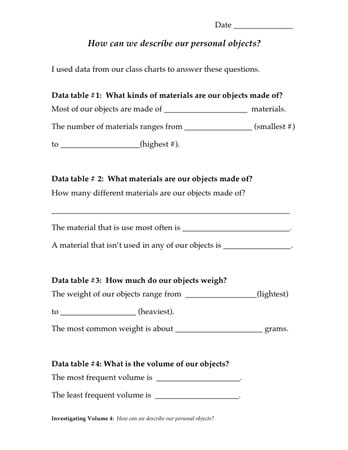How can we describe our personal objects?
Plan Investigating Volume 4
Materials … Weight … Standard Measures … Volume. The students have covered a lot of territory in their study of matter. In this capstone investigation, they apply their skills and understandings to a final task — fully describing the “personal objects” they brought to the first class.
Students first record some data about the materials, weight and volume of their personal objects. They then consider the entire collection of objects, graphing the range of data and placing all the objects on a weight line. This shift from describing a single object to describing a collection of objects is likely to be new for them. By the end of the investigation, they will be making some simple, general observations about the whole set of personal objects, describing common properties and using standard metric measures.
Learning Goals
- to use skills and concepts related to materials, weight, and volume
- to get more experience with data representations (graphs and the weight line)
| Sequence of experiences | ||
|---|---|---|
| 1. Ask the question | All Class | 10 Mins |
| 2. Collect and record data about our objects | Small Groups | 20 Mins |
| 3. Make meaning | Discussion | 15 Mins |
* It is possible for this investigation to be performed within 45 minutes. However, it is recommended that Step 1 and Step 2 be completed within one session as collecting the data can often take longer than expected. Step 3 can be completed in a subsequent session along with any additional reflections you would like to complete this unit.
Materials and Preparation
For the class:- Post the investigation question in a place where all students can see it.
- Histogram 1: Number of Materials in Our Objects
- Histogram 2: Materials Our Objects are Made of
- Histogram 3: Estimated Volume of Our Objects
- The class weight line
- 3 volume reference blocks: 1, 10, 100 cubic centimeters (see the photo in Step 2).
- 10 cubic centimeter reference is created by taping 10 centimeter cubes together
- 100 cubic centimeter reference is created by taping 5 maple blocks labeled B (20 cubic centimeters) together
- 1 gram weight set
- 2 pan balances
- 1 personal or classroom object







